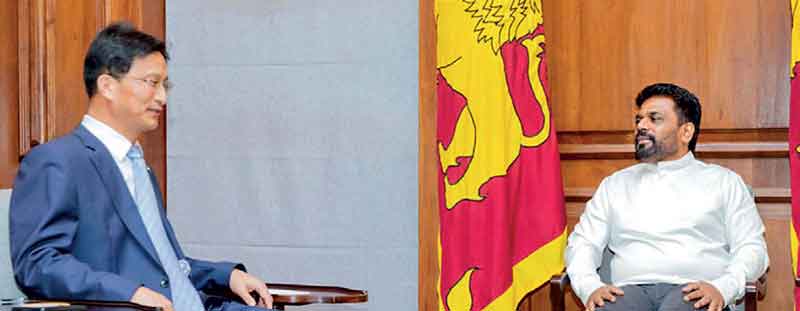Sunday Dec 15, 2024
Sunday Dec 15, 2024
Thursday, 10 October 2024 00:02 - - {{hitsCtrl.values.hits}}

Ambassador of the People’s Republic of China Qi Zhenhong, a great supporter of Sri Lanka’s progress, met with President Anura Kumara Dissanayake

Indian External Affairs Minister Dr. S. Jaishankar met Sri Lankan President Anura Kumara Dissanayake in Colombo on Friday. Dr. Jaishankar recently urged for all Indians to visit Sri Lanka for holiday
 With a new president in office, Sri Lanka is grappling with the aftermath of one of the worst economic crises in its history, which came to a head in 2022. While the former president bore the brunt of public dissatisfaction for enforcing painful austerity measures, many Sri Lankans have since underestimated and largely forgotten the precariousness of the country’s situation at that time.
With a new president in office, Sri Lanka is grappling with the aftermath of one of the worst economic crises in its history, which came to a head in 2022. While the former president bore the brunt of public dissatisfaction for enforcing painful austerity measures, many Sri Lankans have since underestimated and largely forgotten the precariousness of the country’s situation at that time.
Despite some good signs of recovery, Sri Lanka continues to find itself at a strategic crossroads between competing global powers. With its position in the Indian Ocean, the island nation has long attracted the interest of regional and international players. As Sri Lanka seeks to stabilise its economy and secure its country’s future, it will be challenged to carefully balance local and external influences to protect its national interests and ensure medium term long-term recovery given our humongous debt stock.
A man-made crisis
The total economic collapse in 2022 exposed deep vulnerabilities—over-reliance on external and internal borrowings, a fragile economic foundation, and insufficient foreign currency reserves. The Government sought assistance from multiple actors, including the International Monetary Fund (IMF) as well as neighbouring India and China. However, each of these partners brings its own strategic interests, requiring Sri Lanka’s new leadership to perform a delicate balancing act both locally and internationally.
The role of competing powers
China, a key player in Sri Lanka’s infrastructure development, has been a major partner for over decades. Projects like the Colombo Port City and Hambantota Port, funded by Chinese entities, underscore China’s deep economic presence. However, these initiatives have sparked concerns about debt dependency, with critics warning of a potential “debt trap” that could undermine Sri Lanka’s sovereignty. While some of these concerns are politically motivated, they do not fully reflect the broader benefits of Chinese investments, which have strengthened ties since diplomatic relations were established with the People’s Republic of China in 1957 by Prime Minister S.W.R.D. Bandaranaike. Relations between the two countries reached a high point under Prime Minister Sirimavo Bandaranaike, particularly with the historic visit of Premier Zhou Enlai in the same year.
India as the ‘Big Brother’
Sri Lanka is India’s closest neighbour, and the relationship between the two countries spans over 2,500 years. In recent years, this relationship has expanded through growing trade and investment, cooperation in education, culture, and defence, cricket, Bollywood, and broad understanding on major international issues. Historically, the Bandaranaike family shared close ties with India’s Nehru family, which influenced Ceylon’s foreign policy direction after the 1956 elections. Although bilateral relations have fluctuated over the years, India reasserted its influence in 2022 by providing over $ 4 billion in credit lines, fuel supplies, and other crucial assistance, which played a pivotal role in preventing Sri Lanka from descending into a Lebanon-like collapse.
India also prioritised developing the Trincomalee oil tank farm and expanding trade agreements, solidifying its role as a key ally in Sri Lanka’s recovery. However, it is essential to recognise that India’s strategic interests in the Indian Ocean—particularly in balancing global influence—remain central to this partnership. The geographical proximity between the two nations should be seen as a reason for greater cooperation rather than confusion or tension.
The role of Western powers
Western powers, particularly through the IMF and other multilateral institutions, have imposed strict conditions for financial support. These conditions emphasise structural reforms aimed at long-term stability, such as fiscal consolidation, economic transformation, and public sector reforms. Although necessary, these measures are often politically sensitive and sometimes unpopular among the local population, complicating Sri Lanka’s recovery efforts.
Balancing relations for economic growth
To navigate this complex geopolitical landscape, Sri Lanka must adopt a pragmatic and balanced foreign policy approach. A non-aligned strategy—similar to its historical approach—could help Sri Lanka maintain constructive and beneficial relationships with all major powers without becoming dependent on any one for economic assistance. This approach requires careful diplomatic management to ensure that assistance from China, India, and Western institutions aligns with Sri Lanka’s national development goals, ultimately driving economic prosperity for all Sri Lankans.
Additionally, Sri Lanka should strengthen its regional partnerships. Organisations like the Bay of Bengal Initiative for Multi-Sectoral Technical and Economic Cooperation (BIMSTEC) and the South Asian Association for Regional Cooperation (SAARC) offer valuable platforms for fostering regional trade, investment, and technological collaboration. Deepening ties with ASEAN and South Asian countries could provide alternatives to reliance on global powers, thus diversifying Sri Lanka’s economic partnerships, trade, investment and creating a more balanced path to growth.
The way forward
Sri Lanka’s full recovery by 2027 hinges on its ability to skilfully balance competing external influences, manage the debt stock, while pursuing sustainable economic growth. Every leader have their own model and assumptions, but Sri Lanka’s future lies in leveraging foreign partnerships to build economic resilience, enhance infrastructure, and develop human capital, all while safeguarding its sovereignty. A diversified diplomatic and economic strategy, grounded in sustainability and targeted foreign direct investment (FDI), will be key to securing a stable and prosperous future for Sri Lanka and its people. In the final analysis both India and China can play a key role in Sri Lanka’s sustainable recovery and long-term economic stability, given their strategic investments, historical ties, economic influence and political influence in the region.
References:
https://en.wikipedia.org/wiki/Sirimavo_Bandaranaike
https://www.ft.lk/opinion/Dr-Shashi-Tharoor-talks-India-way-for-Sri-Lanka/14-735203
https://youtu.be/sk2OyR7Mi20?si=Fz1KQr4qZycJRfBm